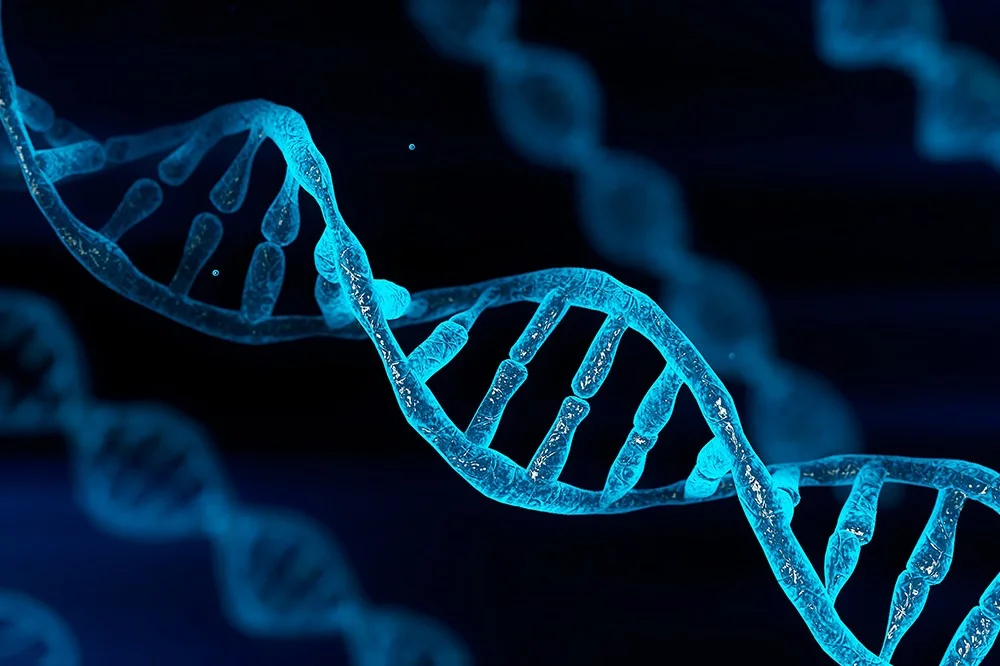The elucidation of DNA’s double-helix structure in 1953 by James Watson and Francis Crick, with critical contributions from Rosalind Franklin and Maurice Wilkins, marked a pivotal moment in scientific history. The discovery of DNA identified deoxyribonucleic acid (DNA) as the molecule of heredity, fundamentally altering our understanding of life and catalyzing advancements across multiple disciplines.
For university and college students, this article provides a technically robust exploration of DNA’s discovery, its scientific foundations, and its transformative impacts on medicine, forensics, agriculture, anthropology, and ethics.
The Scientific Foundation of DNA’s Discovery
Pre-DNA Understanding of Heredity
Before DNA was recognized as the genetic material, heredity was a mystery partially unraveled by Gregor Mendel’s 1860s experiments with pea plants. Mendel’s work introduced the concept of discrete hereditary units (later termed genes), but their chemical nature was unknown.
By the early 20th century, chromosomes were identified as carriers of genetic information, yet scientists debated whether proteins or nucleic acids were the hereditary molecules, with proteins favored due to their chemical complexity.
Key Experiments Leading to DNA’s Identification
Several landmark experiments clarified DNA’s role as the genetic material. In 1928, Frederick Griffith’s transformation experiment demonstrated that a “transforming principle” from heat-killed Streptococcus pneumoniae could transfer genetic traits to live bacteria, suggesting a chemical basis for heredity.
In 1944, Oswald Avery, Colin MacLeod, and Maclyn McCarty built on this, proving that DNA, not protein, was the transforming substance, a finding initially met with skepticism due to DNA’s perceived simplicity.
The 1952 Hershey-Chase experiment further solidified this by using radioactive isotopes to show that DNA, not protein, was the genetic material in bacteriophages, marking a paradigm shift in genetics.
The Double-Helix Breakthrough

In 1953, Watson and Crick published their iconic model of DNA’s structure in Nature, describing it as a double helix of two antiparallel nucleotide strands, each with a sugar-phosphate backbone and nitrogenous bases (adenine, thymine, cytosine, guanine) paired specifically (A-T, C-G) via hydrogen bonds.
This model was informed by Rosalind Franklin’s X-ray diffraction data, particularly Photo 51, which revealed the helical structure and base-pair spacing. The double helix explained DNA’s stability and its replication mechanism, where strands unzip to serve as templates.
The discovery was not without controversy, as Franklin’s contributions were initially underrecognized, despite her data being pivotal. She was excluded from the 1962 Nobel Prize awarded to Watson, Crick, and Wilkins.
Scientific Impacts of DNA’s Discovery
1. Understanding Genetic Mechanisms

The double-helix model illuminated the molecular basis of heredity. DNA replication, where each strand serves as a template for a new complementary strand, was confirmed as semi-conservative by Meselson and Stahl in 1958, using isotopic labeling to track DNA synthesis.
Transcription involves DNA being copied into messenger RNA (mRNA), which is then translated into proteins at ribosomes, following the central dogma (DNA → RNA → protein) proposed by Crick. Deciphering the genetic code—how nucleotide triplets (codons) encode amino acids—enabled researchers to understand protein synthesis, laying the foundation for molecular biology.
2. Molecular Biology and Genetic Engineering
The structural insights into DNA spurred the development of molecular biology. In the 1970s, Paul Berg pioneered recombinant DNA technology, using restriction enzymes to cut and splice DNA, enabling the insertion of genes into bacterial plasmids. This led to the production of human insulin by genetically modified bacteria, revolutionizing diabetes treatment.
The 1983 invention of the polymerase chain reaction (PCR) by Kary Mullis allowed rapid amplification of DNA segments, facilitating genetic analysis. Techniques like gene cloning and DNA sequencing further enabled the mapping of genomes and identification of disease-related genes, transforming biological research.
3. The Human Genome Project

Launched in 1990 and completed in 2003, the Human Genome Project (HGP) sequenced the 3 billion base pairs of the human genome, relying on DNA’s structural understanding and advanced sequencing technologies. The HGP provided a reference genome, enabling studies of genetic variation, disease susceptibility, and evolutionary relationships.
It introduced bioinformatics to handle vast genomic datasets, paving the way for personalized medicine, where treatments are tailored to an individual’s genetic profile, and pharmacogenomics, which optimizes drug therapies based on genetic responses.
Societal and Practical Impacts
1. Medicine and Healthcare
- Genetic Diagnostics

The ability to sequence and analyze DNA has revolutionized medical diagnostics. Identifying mutations in genes like BRCA1 and BRCA2 enables early detection of hereditary breast and ovarian cancers, allowing preventive measures.
Techniques like PCR and next-generation sequencing (NGS) detect rare genetic disorders with high precision, such as cystic fibrosis or Huntington’s disease, by analyzing specific gene mutations. These advancements have shifted medicine toward proactive, genetics-based approaches, improving patient outcomes through early intervention.
- Gene Therapy
Gene therapy corrects genetic defects by introducing functional genes into patients’ cells. For example, treatments for severe combined immunodeficiency (SCID) deliver corrected genes to restore immune function. The development of CRISPR-Cas9 in 2012, a precise gene-editing tool that targets specific DNA sequences, has advanced therapies for conditions like spinal muscular atrophy and sickle cell anemia.
By leveraging DNA’s sequence specificity, CRISPR edits genomes with unprecedented accuracy, though challenges like off-target effects remain.
- Pharmacogenomics
Pharmacogenomics studies how genetic variations affect drug metabolism, enabling personalized treatments. For instance, variations in the CYP2C19 gene influence responses to drugs like clopidogrel, used in heart disease. By tailoring drug prescriptions to a patient’s genetic profile, pharmacogenomics enhances efficacy and minimizes adverse effects, marking a shift from one-size-fits-all medicine to individualized care.
2. Forensics and Criminal Justice
- DNA Fingerprinting: Developed by Alec Jeffreys in 1984, DNA fingerprinting analyzes variable number tandem repeats (VNTRs) to create unique genetic profiles. This technique identifies individuals with near-perfect accuracy, transforming criminal investigations by linking suspects to crime scenes.
It has also exonerated wrongfully convicted individuals, with groups like the Innocence Project using DNA evidence to free over 375 people since 1989. Beyond criminal justice, DNA fingerprinting resolves paternity disputes and identifies remains in mass disasters, such as 9/11 victim identification.
3. Agriculture and Biotechnology

- Genetically Modified Organisms (GMOs): DNA manipulation has revolutionized agriculture through GMOs. Crops like Bt corn, engineered to express a bacterial toxin that repels pests, reduce pesticide use and increase yields. Golden Rice, modified to produce vitamin A, addresses nutritional deficiencies in developing regions. These advancements rely on inserting specific DNA sequences into plant genomes, enhancing resilience and productivity.
- Marker-Assisted Breeding: DNA markers, short sequences associated with desirable traits, accelerate crop breeding. By identifying plants with genes for drought resistance or disease immunity, breeders develop improved varieties faster than traditional methods. This approach has produced climate-resilient crops, critical for food security in the face of global challenges like climate change.
- Synthetic Biology: Synthetic biology designs novel organisms by synthesizing DNA sequences. Applications include bacteria engineered to produce biofuels or pharmaceuticals, such as artemisinin for malaria treatment. By programming DNA, synthetic biology creates sustainable solutions for industrial and medical challenges, building on the molecular understanding of DNA’s function.
4. Anthropology and Evolutionary Biology
- Mitochondrial DNA and Y-Chromosome Studies: Mitochondrial DNA (mtDNA) and Y-chromosome analyses trace maternal and paternal lineages, revealing human migration patterns. For example, mtDNA studies show that modern humans originated in Africa ~200,000 years ago. These analyses also uncovered interbreeding between Homo sapiens and Neanderthals, with ~2% Neanderthal DNA in non-African populations, reshaping our understanding of human evolution.
- Ancient DNA: Sequencing DNA from fossils, such as Neanderthal or Denisovan remains, clarifies evolutionary relationships. Ancient DNA studies confirm that Homo sapiens diverged from archaic species while interbreeding occurred, providing insights into genetic adaptations, such as those for high-altitude living in Tibetans. This field bridges genetics and anthropology, illuminating human history.
Ethical and Social Considerations
1. Genetic Privacy

The rise of direct-to-consumer genetic testing, such as 23andMe, makes genetic data widely accessible, raising concerns about privacy. Misuse by insurers or employers could lead to discrimination, despite protections like the U.S. Genetic Information Nondiscrimination Act (GINA) of 2008. Ensuring secure storage and ethical use of genetic data remains a pressing challenge.
2. Gene Editing
CRISPR’s ability to edit human embryos sparks debates over “designer babies,” where traits like intelligence or appearance could be selected. Gene drives, which spread modified genes through populations (e.g., to control mosquito-borne diseases), risk ecological imbalances. Ethical frameworks must balance innovation with potential risks.
3. Equity in Access
Advanced genetic therapies, like CAR-T cell therapy for cancer, are expensive, limiting access in low-income regions. This exacerbates healthcare disparities, as wealthier nations benefit disproportionately. Global policies are needed to ensure the equitable distribution of DNA-based technologies.
Future Directions
1. Precision Medicine
Initiatives like the All of Us Research Program integrate genomic and health data to personalize treatments, predicting disease risk and optimizing therapies. For example, tailoring cancer treatments to tumor-specific mutations improves survival rates, building on DNA’s role in precision medicine.
2. Synthetic Genomics
Projects like the Synthetic Yeast Genome Project aim to engineer entire genomes, creating organisms with novel functions. Applications include producing complex drugs or sustainable materials, leveraging DNA’s programmability to address global challenges.
3. Epigenetics
Epigenetics studies chemical modifications to DNA, like methylation, that regulate gene expression without altering the sequence. This field reveals how environmental factors influence gene activity, with implications for cancer, aging, and neurological disorders, expanding the legacy of DNA’s discovery.
Final Words
The 1953 discovery of DNA’s double-helix structure unlocked the molecular basis of life, transforming science and society. From enabling genetic diagnostics and gene therapy to revolutionizing forensics and agriculture, DNA’s impact is vast and enduring. For university students, understanding this milestone highlights the power of basic research to drive innovation, while ethical challenges underscore the need for responsible stewardship.
As DNA technologies advance, they promise to further reshape our world, demanding a balance of scientific ambition and societal accountability.

This is Kyle Thomas, a professional writer, and a news editor. I started my career as a blogger who writes on various topics and then I decided that I should join a NEWS agency where I can work as a NEWS reporter. So, I joined a renowned agency in the town as an internet and after getting 2 years of experience, now I am working as a senior NEWS reporter for The Daily NEWS Times.













